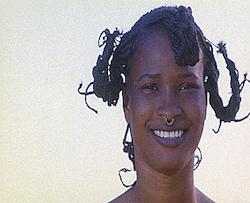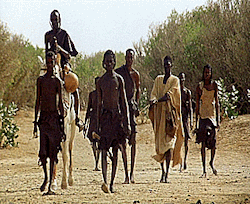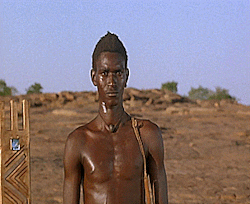#Yeelen FilmReview
Text
Film review of Yeelen (1987) by Souleymane Cisee
Director: Souleymane Cisee
Cast: Balla Moussa Keita, Niamanto Sanogo, Aoua Sangare
IMDb: 7/10
Rotten Tomatoes: 90%
Review:
Yeelen is a Malian film that delves into the topics of magic, death, and betrayal. It is an essential work of cinema that features a father, Soma who uses his magic for evil and selfish desires. One of his dark desires is to murder his son, Nianankoro because it has been predicted that he will be the reason behind Soma’s death. This establishes the theme of utmost betrayal, the betrayal of family, and the disgusting nature of human beings when it comes to survival, like when Nianonkoro kills his uncle before he kills him. It shows that one’s love and importance of family can easily fly out the window when it comes to the security of their own life.
This film shows that there is protection in magic, when Nianonkoro magically freezes the guards from attacking him. Magic also provides superiority and authority as one is capable of controlling the spiritual world, unlike most humans who rely on the unknown of the physical world. Hence those with magic receive praise and respect from everyone around them even despite their evil doings.
The film also shows that prophecy can be a helpful tool in life, it can be used for guidance and foretelling, it offers protection against dangerous forthcoming events and it can reassure one of their greatness and the upcoming successes of their life.
Nevertheless, no amount of magical powers can free a man from the natures of the world and seven deadly sins. Nianokoro is defeated by the sin of lust when he sleeps with the kings’ wife and Kore’s wing creates a blinding wave that kills both Nianonkoro and Soma and transforms the land around them into sand. Magic is its own entity, no amount of sacrifices can change or control its power, and even with the amount of magic one can possess, one can never be omnipotent or omniscient.
The acting in Yeelen is exceptional. The characters gave a natural performance that breathes life into the story. They understood the subtext of the story and block it accordingly, aware to give a great performance for the different shots. The viewer can see that the characters were bouncing off each other’s energy. However, some may argue that some performances were overacted and long, like when the Komo leaders were gathered up drinking traditional beer and one was impersonating a goat, but that is an illustration of how real and supernatural the rituals can be. I believe that the mood and tone the characters create are captivating and provocative.
Here is another recommended film worth a watch. I hope your popcorn is ready.
1 note
·
View note
Photo




All gifs from https://tumblr.net/tagged/yeelen .
YEELEN FILM REVIEW
Yeelen is a 1987 film released by the Malian film director Souleymane Cissé. ‘Yeelen’ means ‘Brightness’ or ‘Light’ in native Bambara. Spoken language in the film is also Bambara, and Fula which is the national language of Mali and natively spoken by some 5 million people.
The basic plot is of a young man, Nianankoro, sent to defeat his father, who uses magic for his own personal gain. Nianankoro must use his own magic as well as stolen fetishes to defeat his father.
I noticed how colour aids the narrative in this film. Various colours are used to convey different emotions - yellow, green, brown, purple and blue. The use of colour was striking to me, and I found it an interesting device to distinguish tribes and their intentions. For example, red is widely known as a ‘dangerous colour’ in film, and when Nianankoro first meets the warriors some of them don red.
In Yeelen, there are long pieces where no dialogue is spoken. Long, slow pans over the desert sands as Nianankoro travels, or as warriors fight. I immediately picked it up. I think film scholars are so used to having dialogue in every scene, overbearing the actions that actually make the film great. This is what Yeelen achieves effortlessly.
The cinematographer also chose to use long takes when scenery is needed to set the scene.
Pans over the scenery are also present in a lot of the takes. This gives the audience a better idea of the surroundings and location. Long takes are used to convey a certain mood, usually one of peace and calm, but it can also be used to create tension, to stretch a moment out. In Yeelen’s case, it is used in partnership with pans - showing the audience the bushveld.
I also found that a lot of the frames were balanced - equal ‘screen weight’ on both sides.
Yeelen is a lovely film about family, morals and tradition and I can definitely recommend that you watch it at least once.
--- SOURCES ---
Cissé, S. (dir). Yeelen. 1987. Atriascop Paris, Burkina Faso Ministry of Life and Culture.
1 note
·
View note